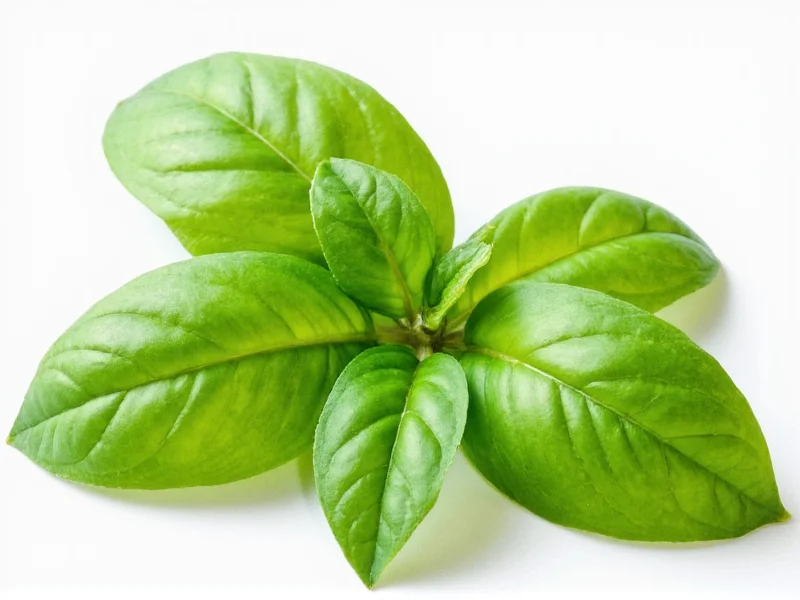When adapting recipes that call for fresh basil but you only have dried on hand, understanding proper herb conversions is essential for balanced flavor. The difference between fresh and dried basil isn't just about quantity—it's about how the drying process concentrates the essential oils and removes moisture, creating a more potent seasoning.
The Science Behind Herb Conversions
Fresh basil contains approximately 90% water, while dried basil has most of this moisture removed through the dehydration process. This concentration means dried basil delivers more intense flavor in a smaller volume. When herbs dry, their essential oils become more concentrated, requiring less quantity to achieve similar flavor impact.
Chef Marco Rodriguez, a culinary instructor with 15 years of experience, explains: "The drying process essentially removes the water that dilutes fresh herbs' flavors. What remains is a more potent version of the same herb, which is why you need significantly less dried product to match fresh."
Understanding the 3:1 Conversion Ratio
The standard conversion ratio between fresh and dried herbs is 3:1—meaning you need three times more fresh herb than dried to achieve equivalent flavor. This ratio works because:
- Dried herbs have lost 80-90% of their water content
- Concentrated essential oils deliver stronger flavor
- Dried herbs disperse more evenly in dishes
- Rehydration during cooking releases flavor gradually
This ratio applies consistently across most culinary herbs including basil, oregano, thyme, and rosemary. However, delicate herbs like cilantro and parsley may require slight adjustments to this standard ratio.
Complete Basil Measurement Conversion Chart
| Fresh Basil | Dried Basil | Best For |
|---|---|---|
| 1/4 cup (4 tablespoons) | 1 tablespoon | Sauces, soups, marinades |
| 1/3 cup | 1 tablespoon + 1 teaspoon | Pasta dishes, pizza |
| 1/2 cup | 1 tablespoon + 2 teaspoons | Tomato-based dishes |
| 1 cup | 3 tablespoons (1/4 cup) | Large batch recipes |
| 2 tablespoons | 2 teaspoons | Finishing touches |
Practical Tips for Using Dried Basil
When substituting dried basil for fresh in your recipes, consider these professional cooking techniques:
- Add dried herbs early: Incorporate dried basil during the cooking process to allow time for rehydration and flavor development
- Crush between fingers: Rub dried basil between your palms before adding to release essential oils
- Start with less: You can always add more, but you can't remove excess dried herb once incorporated
- Consider freshness: Dried herbs lose potency over time—replace your dried basil if it's been stored longer than 6-12 months
- Adjust for dish type: Use slightly less dried basil in delicate dishes like fish or egg preparations
Common Conversion Mistakes to Avoid
Many home cooks make these errors when converting fresh basil to dried:
- Using equal measurements: Treating 1/4 cup fresh basil the same as 1/4 cup dried basil will result in overpowering flavor
- Adding too late: Dried herbs need time to rehydrate—adding them at the end of cooking yields less flavor impact
- Not adjusting for age: Older dried herbs have lost potency and may require slightly more quantity
- Ignoring recipe context: Some dishes (like pesto) fundamentally require fresh basil and don't convert well to dried
When Fresh Basil Is Essential
While dried basil works well in cooked dishes, certain recipes absolutely require fresh basil for proper texture and flavor profile:
- Traditional pesto (the oil extraction process requires fresh leaves)
- Garnishes and finishing touches (dried basil won't provide the same visual appeal)
- Cold dishes like caprese salad (dried basil won't rehydrate properly)
- Cocktail garnishes (fresh provides aromatic release)
For best results with dried basil substitutions, choose recipes where the herb will have time to rehydrate during cooking—sauces, soups, stews, and braises work particularly well with dried basil conversions.
Storing Dried Basil Properly
To maintain optimal flavor for your dried basil conversions:
- Store in airtight containers away from light and heat
- Keep away from strong-smelling spices that can transfer odors
- Replace dried herbs every 6-12 months for maximum potency
- Test potency by rubbing and smelling—if aroma is weak, replace
Properly stored dried basil maintains its flavor concentration, ensuring your 1/4 cup fresh basil to dried basil conversions remain accurate over time.
FAQ: Fresh Basil to Dried Basil Conversions
Can I use dried basil instead of fresh in pesto?
No, traditional pesto requires fresh basil. The oil extraction process that creates pesto's signature texture and flavor depends on fresh basil leaves. Dried basil won't properly emulsify with oil and will result in a gritty, overly concentrated flavor.
Why does 1/4 cup fresh basil equal only 1 tablespoon dried?
This 3:1 ratio exists because dried basil has lost 80-90% of its water content during dehydration. The essential oils and flavor compounds become concentrated, so you need significantly less dried product to achieve similar flavor intensity as fresh basil.
How do I adjust recipes when substituting dried basil for fresh?
For every 3 parts fresh basil called for in a recipe, use 1 part dried basil. For example, if a recipe requires 1/4 cup fresh basil, use 1 tablespoon dried basil instead. Always add dried basil earlier in the cooking process to allow time for rehydration.
Does the conversion ratio differ for other herbs?
Most sturdy culinary herbs follow the same 3:1 fresh-to-dried ratio (basil, oregano, thyme, rosemary). Delicate herbs like parsley, cilantro, and dill may require a 4:1 ratio since they lose more flavor during drying. Always start with less dried herb and adjust to taste.
How can I tell if my dried basil has lost potency?
Rub a small amount between your fingers and smell it. Fresh dried basil should have a strong, sweet, slightly peppery aroma. If the scent is faint or musty, the basil has lost potency and should be replaced. Properly stored dried basil typically maintains good flavor for 6-12 months.











 浙公网安备
33010002000092号
浙公网安备
33010002000092号 浙B2-20120091-4
浙B2-20120091-4